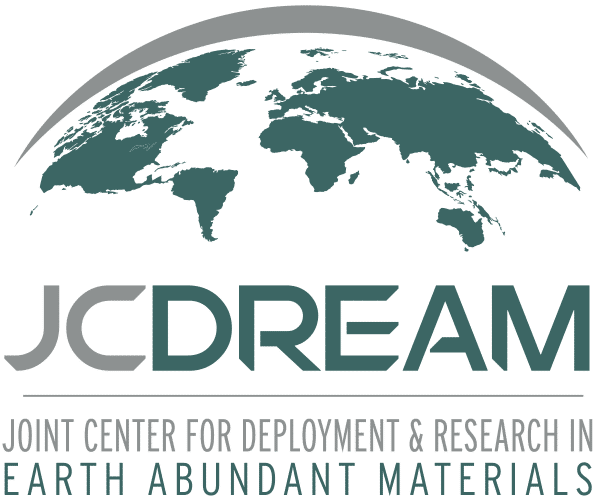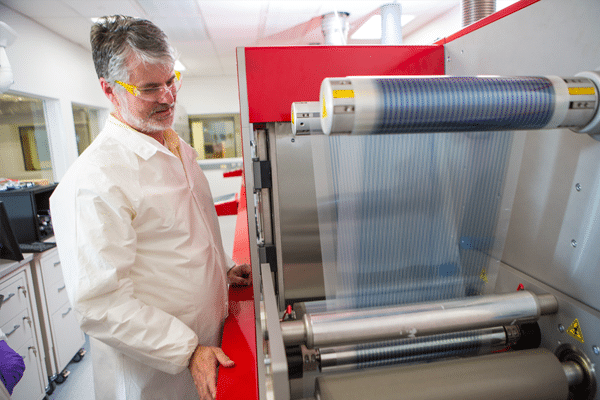Contact:
J. Devin MacKenzie: jdmacken@uw.edu
University of Washington
Materials Science & Engineering
Joint Center for Deployment and Research in Earth Abundant Materials (JCDREAM) awarded $631K to Testbeds to install world’s first roll-to-roll inkjet printer for electronics with sub-micron features
UW Professor J. Devin MacKenzie will use the printer to develop cheap, sustainable alternatives to rare-earth materials used in solar panels, displays, and touchscreens.
The Joint Center for Deployment and Research in Earth Abundant Materials (JCDREAM), a Washington state research collaborative, has awarded $631K to University of Washington (UW) materials science & engineering and mechanical engineering Associate Professor J. Devin MacKenzie and the Washington Clean Energy Testbeds (WCET). MacKenzie will use the funds, which UW will supplement with $187K, to purchase and install an ultra-high-resolution electronics printer developed at SIJ Technology, Inc. and Japan’s National Institute of Advanced Industrial Science and Technology. When integrated with the existing roll-to-roll printer at the Testbeds, it will be the first system capable of high-throughput printing at sub-micron feature sizes. The printer will be available to academic and industry users of the Washington Clean Energy Testbeds for research and development, prototyping, and commercial manufacturing. Advances in printed electronics will allow next-generation electronic devices to be sustainably manufactured with earth-abundant materials.

“We can’t wait to see the impact of this revolutionary additive manufacturing tool in the Testbeds thanks to JCDREAM,” said MacKenzie, Washington Research Foundation Professor of Clean Energy. “Our users can print electronics using sustainable materials with finer control than ever before, and it will directly enable UW and industrial researchers to develop a sustainable alternative for a crucial element of flexible thin-film solar cells, displays and touch screens. This printer, the first of its kind in the world, can also be used to make improved sensors and higher power batteries.”
UW models have shown that electrodes made of earth-abundant materials can be patterned with micron-scale features — smaller than can be seen by the human eye — to make them competitive with vacuum-deposited conventional ITO electrodes. MacKenzie’s research group can now create this alternative using the advanced capabilities of the JCDREAM-funded printer, as conventional inkjet electronics printers are limited to 20-50 micron features. The UW team has already demonstrated printing of conductive electrodes from nanoparticle metal inks at <2 micron in linewidth. That’s about one quarter the size of a single red blood cell. They will develop copper-based transparent electrodes with nanoscale features that will match or exceed the conductivity and transparency of conventional ITO electrodes. The additive printing process will also eliminate the etching process, reducing negative environmental impacts of the runoff as well as the amount of starting raw material.
Ultimately, MacKenzie’s group aims to create a pathway to sustainable, scalable manufacturing of thin-film solar cells. Currently, indium is a limiting factor for thin-film solar cells due to its cost, toxicity, and long environmental life cycle. The copper-based transparent electrodes could also be used in flat-panel TVs, smartphones, and car windshields. Along with the copper-based alternative to indium electrodes that his group is developing, MacKenzie believes that the revolutionary printing system will enable sustainable solutions for batteries, sensors, fuel cells, and catalysts that rely on lithium, palladium, and cobalt. Staff scientists from the WCET and MacKenzie’s group at UW have already trained more then 10 external users, bringing in startup companies and academic users developing new solar, sensors, and electronics technologies from Silicon Valley, Stanford, CalTech and Berkeley as well as local manufacturing companies. UW research on the tool has already begun using this new capability to print new optical ‘metasurfaces’, films that can be made into ultrathin lenses and elements of optical computing. The tool has also been used to create early prototypes of quantum materials as part of a drive to establish a National Science Foundation Science and Technology Center to create “Modern Optoelectronic Materials on Demand”.
“As a cleantech-focused facility that serves academic researchers, startups, and developed companies, the Testbeds are a perfect guidepost for JCDREAM’s mission,” said JCDREAM’s interim executive director David Field. “Our relationship with the Testbeds and other state-supported institutes is crucial to our success. We can’t wait to see the sustainably-sourced and sustainably-produced electronics that Testbeds users will create with this printer.”
JCDREAM is a research collaborative between Washington State University, UW, and the Pacific Northwest National Laboratory, with additional involvement from academic, government, and industrial institutes in the state that are involved in education, research, or manufacturing. It was established in 2015 to stimulate innovation in the use of earth-abundant materials alongside Washington state’s strong clean energy and transportation industries. The upgrade to the Testbeds is just one element of JCDREAM’s program of research, development, deployment, and training, with the goal of national leadership on the challenge posed by unsustainable use of resources and rare earth minerals.
Top left: Professor J. Devin Mackenzie with the roll-to-roll printer at the Washington Clean Energy Testbeds.
Top right: The R&D printer developed at Japan’s AIST and SIJ Technologies being installed in the Testbeds.
Bottom left: a microscope image of printed metal lines 1.75 and 2 micron wide that are so small they are invisible to the naked eye.
Bottom right: A larger custom multinozzle version is being prototyped now and the multinozzle heads will enable integration with flatbed and roll-to-roll printers for the first time.

